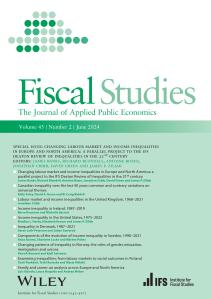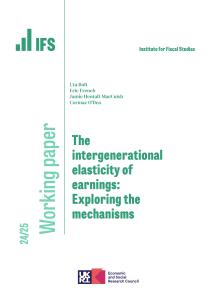Rising employment between 2009–10 and 2013–14 led to increases in the proportion of children living with working parents. At the same time, falls in real earnings reduced the incomes of working families. These two contrasting trends led to absolute child poverty remaining unchanged overall in this period. However, the proportion of children in poverty living in a working family rose from 54% in 2009–10 to 63% by 2013–14.
These are among the findings of a new report by IFS researchers published today: Living Standards, Poverty and Inequality in the UK: 2015, funded by the Joseph Rowntree Foundation. The research uses data on household incomes from the government’s Households Below Average Income series, recently made available up to and including the financial year 2013–14.
Key findings on trends in child poverty include:
- Between 2009–10 and 2013–14, the proportion of children in workless families fell from 18% to 16%. This reduced absolute child poverty by more than 1 percentage point (see notes to editors for cash-terms poverty lines for different family types).
- Over the same period, increased rates of poverty within working families acted to increase absolute child poverty by more than 2ppt. This was caused primarily by falling real earnings. The rate of absolute child poverty in working families rose from 19% to 21%.
- Benefit cuts over this parliament will put upward pressure on absolute poverty for working-age households – including those in work. The planned rises in the minimum wage will help many of those on the lowest hourly pay, but are smaller in overall magnitude than the benefit cuts and less tightly targeted on low-income households.
Looking at other measures of low living standards and financial difficulties:
- Among those in income poverty, ‘material deprivation’ (according to what families say they cannot afford) is much higher for social renters, lone parents and disabled people than for owner-occupiers, the self-employed and those with some savings. In fact, among families with children, social renters with incomes (after housing costs) around the median are at least as likely to be materially deprived as the lowest-income owner-occupiers. This illustrates the importance of looking at more than just current income to understand low living standards.
- Cuts to council tax support and the introduction of the so-called ‘bedroom tax’ in 2013–14 both seem to have caused clear increases in arrears, on council tax and rent respectively. Council tax arrears among working-age recipients of council tax support rose by 10ppt in areas that introduced the highest minimum council tax payments (above 20%), but fell in areas with no minimum payment. Rent arrears increased by 8ppt for those likely to be affected by the so-called ‘bedroom tax’, but were essentially unchanged for other working-age social tenants on housing benefit.
The report also examines changes in average living standards:
- By 2013–14, real median household income was almost back to its pre-recession (2007–08) level though still 2.4% below its 2009–10 peak. Pensioners have done much better than average: median pensioner income in 2013–14 was 7.0% above its 2007–08 level, while median non-pensioner income was still 2.7% below.
- Recent income growth has been much weaker than in the equivalent periods around previous recessions. Median income in 2013–14, four years after the peak, was about the same as seven years earlier in 2006–07. Over the corresponding seven-year period around previous recessions in the 1970s, 1980s and 1990s, median income grew by between 13% and 17%. This mostly reflects slow growth before and after the recession, rather than particularly large peak-to-trough falls in income.
The report also analyses changes in inequality, over the short and longer run:
- Inequality amongst the majority of the population has fallen since 1990. In 2013–14, incomes at the 90th percentile were 3.8 times those at the 10th percentile, compared with 4.4 times in 1990. Much of this fall has happened since the recession.
- But the top 1% have been taking an increasing share of household income, up from 5.7% in 1990, to 8.4% in 2007–08 prior to the crisis (and 8.3% in 2013–14).
- The fall in inequality partly reflects the ‘catch-up’ of pensioners. The median pensioner now has a higher income than the median non-pensioner (after accounting for housing costs), having been more than 30% poorer in 1990.
- Workless households have also been catching up with those in work. Excluding pensioners, median income (after housing costs) for workless households is 46% of the median among working households, up from 39% in 1990.
- Inequality among working households was rising before the recession, but has fallen since 2007–08. This fall reflects the fact that lower-earning working households get more support from in-work benefits, which have been more stable than earnings.
“The recent stability in absolute income poverty among children has masked important and offsetting trends,” said Chris Belfield, a Research Economist at the IFS, and an author of the report. “Since 2009–10, a fall in the number of workless families has acted to reduce poverty, but this has been offset by a substantial rise in in-work poverty. This largely reflects the wider nature of the labour market since the recession: robust employment and weak earnings.”
Robert Joyce, a Senior Research Economist at the IFS and another author of the report, said: “The government has recently emphasised worklessness as a cause of poverty. This makes sense, but tackling low living standards will be difficult without improvements for working families too.”
Julia Unwin, Chief Executive of the Joseph Rowntree Foundation, said: “A strong economy and rising employment have masked the growing problem of in-work poverty, as years of below-inflation wage rises have taken their toll on people’s incomes. The upcoming minimum wage rise will help, but many low-income working families will still find themselves worse off due to tax credit changes. Boosting productivity and creating more jobs which offer progression at work is vital to make work a reliable route out of poverty.”
ENDS
Notes to Editors:
1. The full Households Below Average Income publication can be found at https://www.gov.uk/government/statistics/households-below-average-income-19941995-to-20132014.
2. Embargoed copies of the full report, Living Standards, Poverty and Inequality in the UK: 2015, are available on request. The report will also be available on the IFS website from 00:01 AM on Thursday 16 July 2015.
3. The authors are very grateful for financial support from the Joseph Rowntree Foundation for the project ‘Living Standards, Poverty and Inequality in the UK: 2015’. Co-funding from the ESRC-funded Centre for the Microeconomic Analysis of Public Policy at IFS is also very gratefully acknowledged.
Absolute poverty lines (£ per week) in 2013–14 for example families (assuming any children are under 14), measuring household income net of direct taxes, including benefits and after housing costs have been deducted:
Single individual | Childless couple | Lone parent, one child | Couple, one child | Couple, two children | Couple, three children |
£136 | £235 | £183 | £282 | £329 | £376 |










